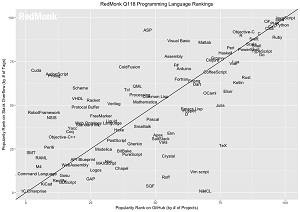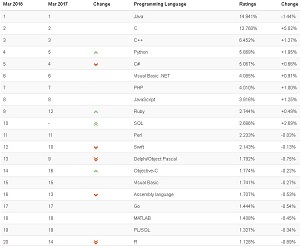News
What's New in Programming Language Popularity
- By David Ramel
- March 9, 2018
Both the TIOBE Index and RedMonk Programming Language Rankings issued new reports this week to track the popularity of programming languages, with old favorites -- especially Java and JavaScript -- continuing to dominate.
For highlights, TIOBE noted Ruby's ascension into its top 10 at the expense of Delphi, while RedMonk cited the possible plateau of fast-rising Go and the continuing run of Kotlin, characterized as the second-fastest growing language it has seen since Swift began to replace Objective-C for iOS development.
While a nebulous subject that's difficult to track consistently, the popularity of programming languages can serve as useful guidance for developers. As TIOBE says, "The index can be used to check whether your programming skills are still up to date or to make a strategic decision about what programming language should be adopted when starting to build a new software system."
RedMonk, meanwhile, says, "The idea is not to offer a statistically valid representation of current usage, but rather to correlate language discussion and usage in an effort to extract insights into potential future adoption trends."
Although published this week (in March), the RedMonk report contains data compiled for January 2018 and its index label reflects that. Here's the top 10 comparison between this year's ranking and last year's, with a couple ties factored in (and noting that there have been some methodology changes in compiling data for the ranking):
RedMonk Programming Language Rankings
| Rank |
January 2018 |
January 2017 |
| 1 |
JavaScript |
JavaScript |
| 2 |
Java |
Java |
| 3 |
Python |
Python |
| 4 |
PHP |
PHP |
| 5 |
C# |
C#, C++ |
| 6 |
C++ |
|
| 7 |
CSS |
CSS, Ruby |
| 8 |
Ruby |
|
| 9 |
C |
C |
| 10 |
Swift |
Objective-C |
"As always, the consistent performance of our Tier 1 languages -- the top 10, more or less -- is at once surprising and unsurprising," RedMonk said. "The relatively static nature of the top 10 languages is interesting, certainly, in a technology landscape that is best characterized not by the high level of change but the increasing pace of same.
"Conversely, however, it's important to note that the numbers measured are accretive, and as with financial metrics rates of growth are fastest when projects are new and harder and harder to come by over time. New language entrants are behind from the day they are released, in other words, which makes displacing the most popular languages a significant and uphill battle."
RedMonk also singled out the fast-rising Kotlin language for special attention, as it was vaulted into the limelight when Google named it a first-class option for Android development (along with Java).
"As we noted in our last run, the combination of Kotlin's attractiveness to Java developers and its elevation to first-class citizen on the Android platform seemed to indicate the language was poised for a major jump. In the course of little more than a year, Kotlin has gone from #65 to #46 in our Q3 run to #27 as of January. It didn't quite match the performance of Swift, which managed a #68 to #22 jump in half that time, but Kotlin is now the second fastest growing language we have seen after Apple's successor to Objective-C."
Here's a plotting graphic showing more detail about the RedMonk report, with indices related to the number of StackOverflow tags and number of projects on GitHub:
 [Click on image for larger view.]
January 2018 RedMonk Ranking (source: RedMonk)
[Click on image for larger view.]
January 2018 RedMonk Ranking (source: RedMonk)
Here's the March 2018 TIOBE report compared with 2017 (also noting some changes made to the definition of the index):
TIOBE Index
| Rank |
March 2018 |
March 2017 |
| 1 |
Java |
Java |
| 2 |
C |
C |
| 3 |
C++ |
C++ |
| 4 |
Python |
C# |
| 5 |
C# |
Python |
| 6 |
Visual Basic .NET |
Visual Basic .NET |
| 7 |
PHP |
PHP |
| 8 |
JavaScript |
JavaScript |
| 9 |
Ruby |
Delphi/Object Pascal |
| 10 |
SQL |
Swift |
"Ruby is back in the TIOBE index top 10 and now it seems to be for a longer time," TIOBE said. "If we take a look at the chart of Ruby it follows a very common pattern for programming languages. Ruby was invented a very long time ago and it remained in obscurity till 2006. That was when the Ruby on Rails framework was released. This framework made it easy to create web applications and because Ruby was the underlying language it skyrocketed in the TIOBE index at that time from position 40 to a top 10 position. It also was awarded the TIOBE programming language of the year in 2006. All new language gurus were in ecstasy about Ruby.
The language peaked in 2008, but then all hipsters moved to a new language and Ruby dropped to one third of its popularity. It remained there for a long time but is now catching up very slowly. The fact that it is getting more popular so gradually is a good sign. This means that its increase in popularity is structurally instead of being pushed by hypes. Some other interesting moves this month are that both Julia and Kotlin entered the top 40, whereas Rust and Groovy lost their positions in the top 50."
Here's a snapshot of the TIOBE Index in more detail:
 [Click on image for larger view.]
TIOBE Index for March 2018 (source: TIOBE Index)
[Click on image for larger view.]
TIOBE Index for March 2018 (source: TIOBE Index)
For more details on the respective rankings -- including methodology and definition changes -- see this RedMonk post and this TIOBE post.
About the Author
David Ramel is an editor and writer at Converge 360.